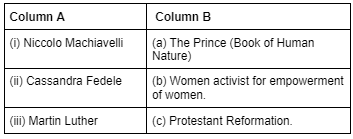Humanities/Arts Exam > Humanities/Arts Questions > Match the persons with the event/works relat...
Start Learning for Free
Match the persons with the event/works related to them

- a)(i) - (a), (ii) - (b), (iii) - (c)
- b)(i) - (b), (ii) - (a), (iii) - (c)
- c)(i) - (c), (ii) - (a), (iii) - (b)
- d)None of these
Correct answer is option 'A'. Can you explain this answer?
Most Upvoted Answer
Match the persons with the event/works related to thema)(i) - (a), (i...
A

|
Explore Courses for Humanities/Arts exam
|

|
Similar Humanities/Arts Doubts
Match the persons with the event/works related to thema)(i) - (a), (ii) - (b), (iii) - (c)b)(i) - (b), (ii) - (a), (iii) - (c)c)(i) - (c), (ii) - (a), (iii) - (b)d)None of theseCorrect answer is option 'A'. Can you explain this answer?
Question Description
Match the persons with the event/works related to thema)(i) - (a), (ii) - (b), (iii) - (c)b)(i) - (b), (ii) - (a), (iii) - (c)c)(i) - (c), (ii) - (a), (iii) - (b)d)None of theseCorrect answer is option 'A'. Can you explain this answer? for Humanities/Arts 2025 is part of Humanities/Arts preparation. The Question and answers have been prepared according to the Humanities/Arts exam syllabus. Information about Match the persons with the event/works related to thema)(i) - (a), (ii) - (b), (iii) - (c)b)(i) - (b), (ii) - (a), (iii) - (c)c)(i) - (c), (ii) - (a), (iii) - (b)d)None of theseCorrect answer is option 'A'. Can you explain this answer? covers all topics & solutions for Humanities/Arts 2025 Exam. Find important definitions, questions, meanings, examples, exercises and tests below for Match the persons with the event/works related to thema)(i) - (a), (ii) - (b), (iii) - (c)b)(i) - (b), (ii) - (a), (iii) - (c)c)(i) - (c), (ii) - (a), (iii) - (b)d)None of theseCorrect answer is option 'A'. Can you explain this answer?.
Match the persons with the event/works related to thema)(i) - (a), (ii) - (b), (iii) - (c)b)(i) - (b), (ii) - (a), (iii) - (c)c)(i) - (c), (ii) - (a), (iii) - (b)d)None of theseCorrect answer is option 'A'. Can you explain this answer? for Humanities/Arts 2025 is part of Humanities/Arts preparation. The Question and answers have been prepared according to the Humanities/Arts exam syllabus. Information about Match the persons with the event/works related to thema)(i) - (a), (ii) - (b), (iii) - (c)b)(i) - (b), (ii) - (a), (iii) - (c)c)(i) - (c), (ii) - (a), (iii) - (b)d)None of theseCorrect answer is option 'A'. Can you explain this answer? covers all topics & solutions for Humanities/Arts 2025 Exam. Find important definitions, questions, meanings, examples, exercises and tests below for Match the persons with the event/works related to thema)(i) - (a), (ii) - (b), (iii) - (c)b)(i) - (b), (ii) - (a), (iii) - (c)c)(i) - (c), (ii) - (a), (iii) - (b)d)None of theseCorrect answer is option 'A'. Can you explain this answer?.
Solutions for Match the persons with the event/works related to thema)(i) - (a), (ii) - (b), (iii) - (c)b)(i) - (b), (ii) - (a), (iii) - (c)c)(i) - (c), (ii) - (a), (iii) - (b)d)None of theseCorrect answer is option 'A'. Can you explain this answer? in English & in Hindi are available as part of our courses for Humanities/Arts.
Download more important topics, notes, lectures and mock test series for Humanities/Arts Exam by signing up for free.
Here you can find the meaning of Match the persons with the event/works related to thema)(i) - (a), (ii) - (b), (iii) - (c)b)(i) - (b), (ii) - (a), (iii) - (c)c)(i) - (c), (ii) - (a), (iii) - (b)d)None of theseCorrect answer is option 'A'. Can you explain this answer? defined & explained in the simplest way possible. Besides giving the explanation of
Match the persons with the event/works related to thema)(i) - (a), (ii) - (b), (iii) - (c)b)(i) - (b), (ii) - (a), (iii) - (c)c)(i) - (c), (ii) - (a), (iii) - (b)d)None of theseCorrect answer is option 'A'. Can you explain this answer?, a detailed solution for Match the persons with the event/works related to thema)(i) - (a), (ii) - (b), (iii) - (c)b)(i) - (b), (ii) - (a), (iii) - (c)c)(i) - (c), (ii) - (a), (iii) - (b)d)None of theseCorrect answer is option 'A'. Can you explain this answer? has been provided alongside types of Match the persons with the event/works related to thema)(i) - (a), (ii) - (b), (iii) - (c)b)(i) - (b), (ii) - (a), (iii) - (c)c)(i) - (c), (ii) - (a), (iii) - (b)d)None of theseCorrect answer is option 'A'. Can you explain this answer? theory, EduRev gives you an
ample number of questions to practice Match the persons with the event/works related to thema)(i) - (a), (ii) - (b), (iii) - (c)b)(i) - (b), (ii) - (a), (iii) - (c)c)(i) - (c), (ii) - (a), (iii) - (b)d)None of theseCorrect answer is option 'A'. Can you explain this answer? tests, examples and also practice Humanities/Arts tests.

|
Explore Courses for Humanities/Arts exam
|

|
Signup for Free!
Signup to see your scores go up within 7 days! Learn & Practice with 1000+ FREE Notes, Videos & Tests.





















